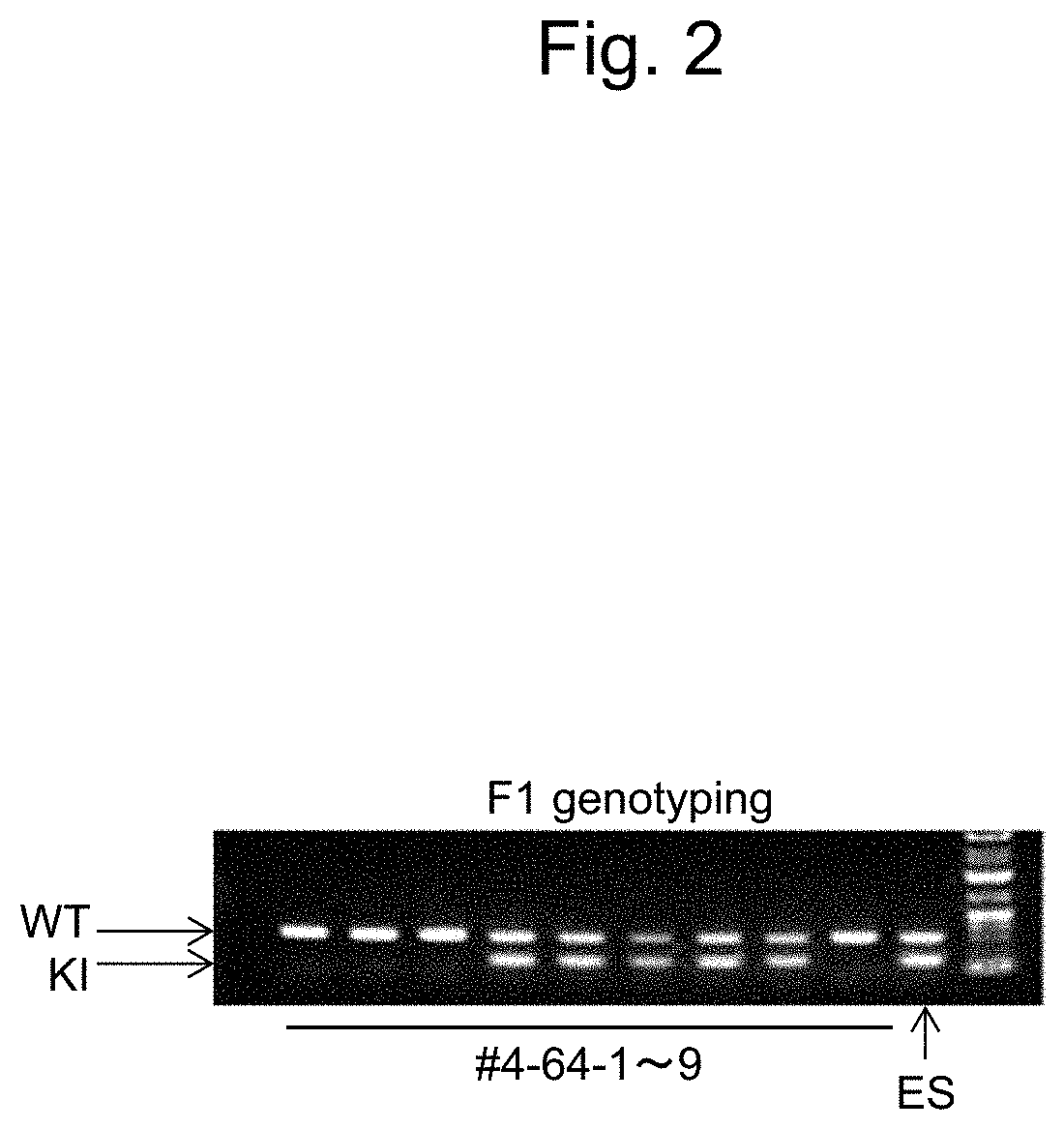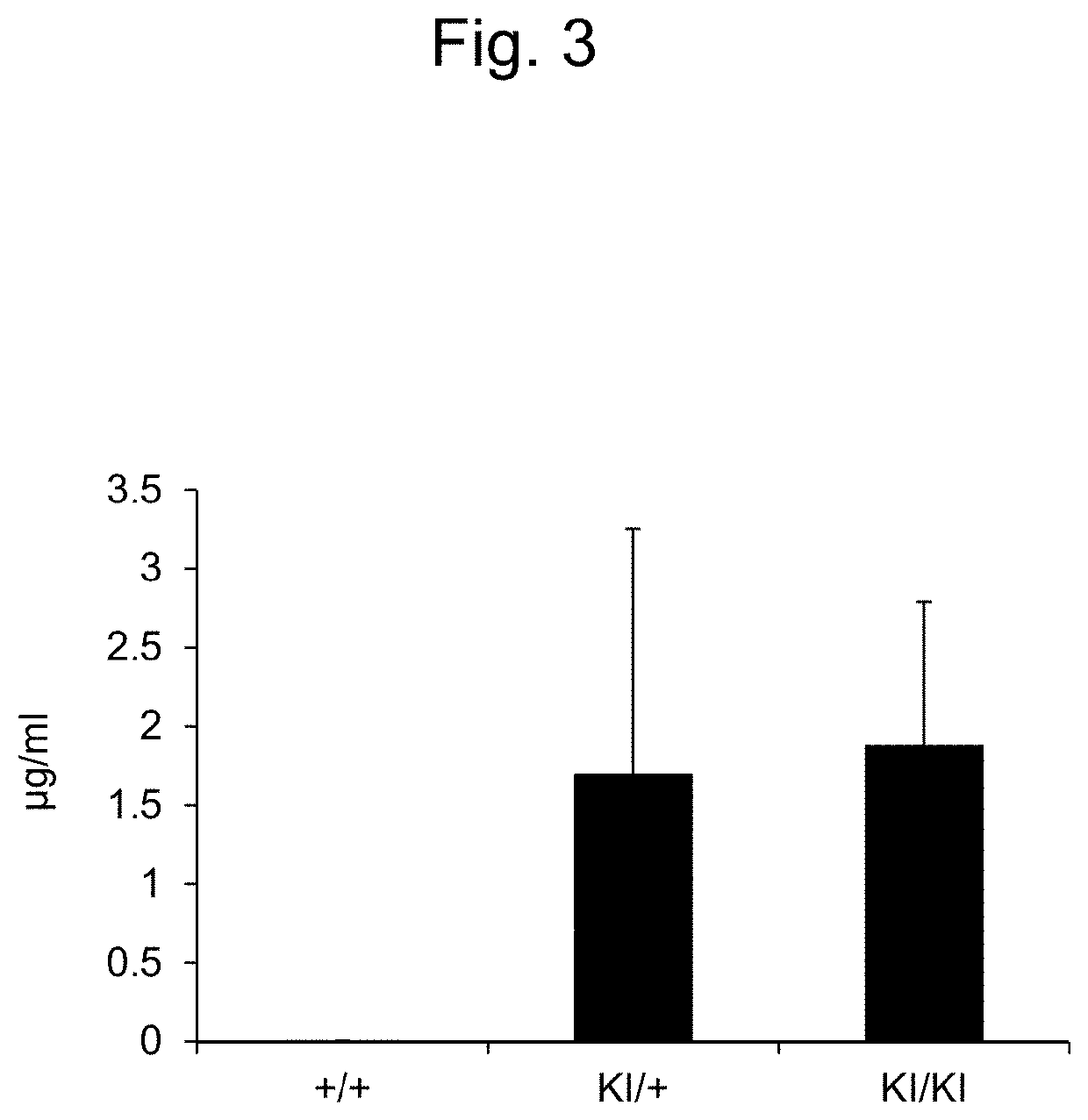Immunodeficient rodent
a technology of immunodeficiency and rodent, applied in the field of rodents, can solve the problems of not being able to obtain the amount of human eosinophils and basophils is maintained for a long time, and the system dedicated to the human innate immune system cannot be obtained
- Summary
- Abstract
- Description
- Claims
- Application Information
AI Technical Summary
Benefits of technology
Problems solved by technology
Method used
Image
Examples
example 1
[Example 1] Human G-CSF Knock-In Mouse in which Human Neutrophils Differentiate
[0137]1. Preparation of KI Targeting Vector
[0138]A KI targeting vector was prepared by placing a human G-CSF gene directly downstream of a systemic expression promoter, i.e., cytomegalovirus (CMV) promoter, and sandwiching it between homologous sequences, that is, a sequence (3.3 Kb) upstream of a mouse G-CSF receptor region and a sequence (6.5 Kb) downstream thereof. The structure of the targeting vector is shown in FIG. 1.
[0139]2. Preparation of Human G-CSF Knock-In Mouse
[0140]The targeting vector prepared as mentioned above was introduced in NOG-mouse ES cells by electroporation to establish homologous recombination ES cells. Thereafter, chimera mice were prepared and crossed with NOG mice to prepare F1 mice. A G-CSF receptor gene was analyzed by a PCR method. The results of the gene analysis are shown in FIG. 2. The mouse strain established is officially expressed as NOD.Cg-PrkdcscidIl2rgtm1SugCsf3rtm...
example 2
[Example 2] Increase of Human Neutrophils by Crossing with FcR KO Mice
[0175]FcR KO mice deficient in Fcer1g and Fcgr2b, which are constituent molecules of a receptor that binds to the Fc region of an antibody, have been already established (Inoue Y et al., Journal of immunology 2007; 179: 764-774). The FcR KO mice were crossed with hG-CSF KI mice to newly establish hG-CSF KI, FcR KO mice. When human hematopoietic stem cells were transplanted into hG-CSF KI, FcR KO mice, it was found that the ratio of human neutrophils in human leukocytes of mice peripheral blood is about 2 to 5% in the hG-CSF KI mice, whereas the ratio is 15 to 20% (4 times higher) in the hG-CSF KI, FcR KO mice (FIG. 19). Neutrophils differentiated from hematopoietic stem cells in the bone marrow in a G-CSF dependent manner, more differentiated in response to stimulation such as infection and quickly migrate to the site stimulated to successfully remove bacteria.
example 3
[Example 3] Increase of Human Eosinophils by Crossing with FcR KO Mice
[0176]hIL-3 / hGM-CSF Tg mice that the present inventors already reported (Ito R et al. Journal of immunology 2013; 191: 2890-2899.) were crossed with the FcR KO mice to newly establish hIL-3 / hGM-CSF Tg, FcR KO mice. When human hematopoietic stem cells were transplanted to hIL-3 / hGM-CSF Tg, FcR KO mice, it was found that the ratio of human eosinophils in peripheral blood is about 2 to 5% in hIL-3 / hGM-CSF Tg mice, whereas the ratio is 10 to 15% (three times higher) in hIL-3 / GM-CSF Tg, FcR KO mice (FIG. 20).
[0177]Similarly, hIL-3 / hGM-CSF / hIL-5 Tg mice (Ito R et al., JCI Insight. 2018 Nov. 2; 3 (21)) were crossed with FcR KO mice to newly establish hIL-3 / hGM-CSF / hIL-5 Tg, FcR KO mice. When human hematopoietic stem cells were transplanted into hIL-3 / hGM-CSF / hIL-5 Tg, FcR KO mice, it was found that the ratio of human eosinophils in human leukocytes of mouse peripheral blood is about 10 to 15% in the hIL-3 / hGM-CSF Tg mice...
PUM
| Property | Measurement | Unit |
|---|---|---|
| concentration | aaaaa | aaaaa |
| concentration | aaaaa | aaaaa |
| Tg | aaaaa | aaaaa |
Abstract
Description
Claims
Application Information
 Login to View More
Login to View More - R&D
- Intellectual Property
- Life Sciences
- Materials
- Tech Scout
- Unparalleled Data Quality
- Higher Quality Content
- 60% Fewer Hallucinations
Browse by: Latest US Patents, China's latest patents, Technical Efficacy Thesaurus, Application Domain, Technology Topic, Popular Technical Reports.
© 2025 PatSnap. All rights reserved.Legal|Privacy policy|Modern Slavery Act Transparency Statement|Sitemap|About US| Contact US: help@patsnap.com



